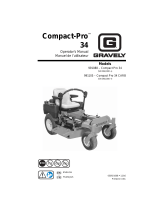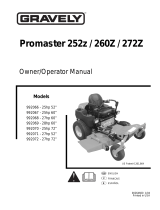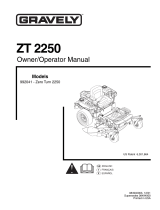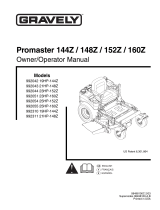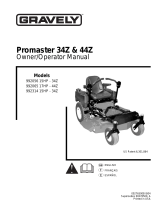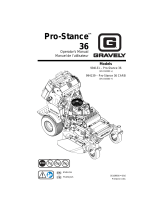
GB - 9
Read, understand, and follow all instructions
in the manual and on the machine before
starting. Understand:
• How to operate all controls
• The functions of all controls
• How to STOP in an Emergency
• Braking and steering characteristics
• Turning radius and clearance
ALWAYS keep protective structures, guards,
and panels in good repair, in place and
securely fastened.
NEVER modify or remove safety devices.
ALWAYS keep discharge cover or complete
grass catcher in place and in proper working
condition.
Check steering control operation frequently.
Adjust and service as required.
Always hold on to safety bar while operating.
Safety Interlock System must function
properly. DO NOT operate unit if operator
presence control is damaged or disabled.
If you strike an object, or if equipment
vibrates abnormally, stop engine at once,
disengage PTO, wait for all moving parts to
stop, and remove key. Check for any damage
or loose parts. Repair before restart.
Before starting engine: disengage PTO,
engage parking brake and place unit in
neutral.
DO NOT operate at too fast a rate. DO NOT
change engine governor settings or over-
speed engine. Slow down and turn corners
slowly.
Disengage PTO when attachment is not in
use. DO NOT raise deck with blades running.
ALWAYS turn off power to attachment when
travelling, crossing driveways, etc.
Avoid uneven and rough terrain. DO NOT
operate near drop-offs, ditches, or
embankments. Unit can suddenly turn over if
a wheel is over the edge of a cliff or ditch, or if
an edge caves in.
When engine is running and speed control
lever is forward, holding only one steering
lever will cause unit to circle around one drive
wheel.
Use care when approaching blind corners,
shrubs, trees or other objects that may
obscure view.
ALWAYS disengage PTO, stop unit and
engine, set parking brake, remove key and
allow moving parts to stop before clearing
clogs or cleaning unit.
Never leave a running unit unattended.
ALWAYS shut off engine before leaving unit.
ALWAYS remove key to prevent unauthorized
use.
DO NOT operate in reverse unless absolutely
necessary. ALWAYS backup slowly. ALWAYS
look down and behind, before and while
backing.
Turf conditions can affect the unit’s stability.
If machine stops going uphill, stop blades and
back down slowly.
Operation on slopes may lead to loss of
steering control. When operating on slopes
be prepared to react to an emergency
situation:
• Return steering levers to neutral
position.
• Immediately set parking brake.
• Turn off PTO and engine.
DO NOT operate on steep slopes. DO NOT
operate on slopes of more than 15°. Operate
across the face of slopes, not up and down.
Keep all movement on slopes slow and
gradual. DO NOT make sudden changes in
speed or direction. Use a slow speed to avoid
stopping or shifting on slopes. Avoid starting
or stopping on a slope.
If you cannot back up a slope or you feel
uneasy on it, do not mow it.
DO NOT park unit on a slope unless
absolutely necessary. When parking on a
slope always engage parking brake and block
wheels.
Use extra care when loading or unloading
unit onto trailer or truck.
Secure unit chassis to transport vehicle.
NEVER secure from rods or linkages that
could be damaged.
DO NOT transport machine while engine is
running.
Properly remove fuel before tipping unit.
Keep unit free of grass, leaves, or other
debris. Clean up oil or fuel spills.
This product is equipped with an internal
combustion engine. DO NOT use on or near
any unimproved, forest covered or brush
covered land unless the exhaust system is
equipped with a spark arrester meeting
applicable local, state or federal laws. A spark
arrester, if used, must be maintained in
effective working order by the operator.
Fuel is highly flammable and its vapors are
explosive. Handle with care. Use only an
approved gasoline container with an
appropriately sized dispensing spout.
No smoking, No sparks, No flames. ALWAYS
allow engine to cool before servicing.




















